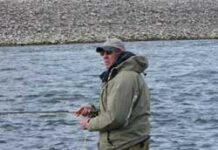As we stepped up to the first hole of the morning — an outside bend in the river — Jim Bos asked me if I was ambidextrous. And before I could even answer, he said, “I’m going to make you ambidextrous.”
We were fishing with two-handed rods, long (12 ½ feet) and fairly heavy (7/8 weight), and Bos told me to grip it as though I were a left-handed batter, with my left hand above the reel. It was cold — 12 degrees — and Bos said it was the best way to fish for steelhead when it’s well below freezing.
The drill was fairly simple: shake out enough fly line so you can reach the run, let it drift downstream, and when the drag on the fly loads the rod, swing it upstream — sort of a hybrid roll/spey cast — and then, mend, mend, mend to achieve a drag-free drift. It took me a couple of times to get it right and then, on my fourth or fifth cast, I saw the bobber go down, set the hook, and watched helplessly as the fish charged upstream. It had me in a fallen treetop in about two seconds.
“Landing a steelhead is a 50-50 proposition, no matter how skilled you are,” the 67-year-old, mostly retired physician said. “And I’m happy with a 50 percent batting average. The fish has a lot of advantages and it’s going to use them. You have anticipate what the fish is going to do and react before it does it.”
It was the only fish I hooked that morning in the three holes we fished. Bos hooked one — a brown trout that was every bit of 20 inches — that pulled off as he prepared to land it.
We went back out in the afternoon and fished, uneventfully, until a little after 5 p.m. when I stuck a nice, colored up steelhead. I had to pressure him to keep him from getting into the brush and timber surrounding the hole, but I did, and Bos, who guessed him at 27 inches, held him for a photo and let him go.
I took a break to take photos — of the gear, the fly (more on that later) and Bos casting — and when I returned to the hole, first cast, wham, bobber goes down, I set the hook. It was another highly colored male and bigger than the first. I held on to him for several minutes, steering him away the obstructions and was hauling him up to the bank when he pulled off.
I had him close enough to net — had we brought one. Boss eschews nets.
“It gets in the way when you’re wading and going through the woods and, number two, I think it’s hard on the fish,” he said. “I’m going to release them anyway, why beat them up? You don’t need it. You can beach them. If I can get them up to where I can grab the line, I feel I’ve got my sport out of them. Other than the grip-and-grin photo opportunities that are lost, I don’t feel I need to hold them.”
That’s where we differ. I trade in photos. But back to the gear.
Bos says by using a working line instead of traditional casting, he’s not reeling it though the line guides, ergo, he’s not stopping to break ice out of the rod eyes every couple of casts.
“I don’t want to touch my line, I don’t want it coiled in my hand,” he explained. “So to do that, you need a long enough lever to work the line. If you get much shorter than 11 1/2 feet, you’re not going to move enough line to make it work.
But much longer than that, it’s longer than you need. On a small river with lots of overhanging limbs, it’s going to get in your way.”
Bos uses 12-pound test monofilament line for the butt section (he likes Maxima as it’s tough, he said), a small weight and a small black (he insists on black) swivel. And he uses a short, eight-pound fluorocarbon leader.
“Twenty inches, sometimes less,” he said. “I never go beyond 24. Sometimes I’ll start at 24, especially if I’m fishing where I know I’m going to be I’m busting off a lot. And I’ve caught them at 15 inches, under a bobber.”
Bos’ theory is that with long leaders, the fish has to pull it that much further to make the bobber go down, and you miss bites.
I was using an Oregon cheese-colored egg pattern, which Bos says has been his most productive fly this year.
“It’s a faded yellow — I think it looks like a washed-out egg,” he said, “what an egg look like that’s been under water a long time. I tie a fluff of orange yarn — that becomes your eye — and a fluff of Oregon cheese on top, a fluff on the bottom, and you’re done.”
He ties the flies on a No. 6 Gamakatsu hook.
We had one more hole. I hooked another — a big, bright, chrome hen that came out of the water twice.
I had it at Bos’ feet and he was reaching for it when it came unbuttoned. Sigh.
So I wound up going one for four. But given the dearth of steelhead this year and that I was learning a new technique, I’d say it was quite a successful day, wouldn’t you?
Credit: Source link































